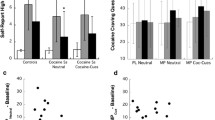Abstract
Several drugs have been shown to exert antipsychotic effects, yet they display an atypical profile with respect to standard neuroleptic drug screens. Low doses of traditional neuroleptics are known to increase self-administration of psychomotor stimulants; we sought to determine whether these atypical drugs would cause a comparable effect. Sulpiride, metoclopramide and thioridazine produced a dose-dependent increase in cocaine intake similar to that found for chlorpromazine, haloperidol, pimozide and flupenthixol. This effect was found to correlate (r=0.94) with daily clinical dose. Clozapine, however, produced a dose-dependent decrease in cocaine intake. The advantages and disadvantages of using this measure as a screening procedure for neuroleptic drugs are discussed.
Similar content being viewed by others
References
Al-Shabibi UMH, Doggett, NS (1980) Clozapine's antiacetylcholine property property modulates its antistereotypic action in the mesolimbic system. J Pharm Pharmacol 32:359–361
Anden N-E (1972) Dopamine turnover in the corpus striatum and the limbic system after treatment with neuroleptic and antiacetylcholine drugs. J Pharm Pharmacol 24:905–906
Anden N-E, Stock G (1973) Effect of clozapine on the turnover of dopamine in the corpus striatum and in the limbic system. J Pharm Pharmacol 25:346–348
Arnfred T, Randrup A (1968) Cholinergic mechanism in brain inhibiting amphetamine stereotyped behavior. Acta Pharmacol Toxicol 26:384–394
Bartholini G (1976) Differential effect of neuroleptic drugs on dopamine turnover in the extrapyramidal and limbic system. J Pharm Pharmacol 28:429–433
Bowers MB, Rositis A (1974) Regional differences in homovanillic acid concentrations after acute and chronic administration of antipsychotic drugs. J Pharm Pharmacol 26:743–745
Carlton P, Didamo P (1961) Augmentation of the behavioral effects of amphetamine by atropine. J Pharmacol Exp Ther 132:91–96
Costall B, Naylor RJ (1975) Detection of the neuroleptic properties of clozapine, sulpiride and thioridazine. Psychopharmacologia 43:69–74
De Maio D (1969) Preliminary clinical evaluation of a new neuroleptic agent: HF 1854. In: Cerletti A, Bove FJ (eds) The present status of psychotropic drugs. Amsterdam, Excerpta Medica Foundation, Amsterdam, p 485
De Wit H, Wise RA (1977) Blockade of cocaine reinforcement in rats with the dopamine receptor blocker pimozide, but not the noradrenergic blockers phentolamine and phenoxybenzamine. Can J Psychol 31:195–203
Gill CA, Holz WC, Zirkle C (1975) The role of dopamine in self-administration of psychomotor stimulants. Reported to the NAS-NRC Committee on Problems of Drug Dependence
Howard JL, Large BT, Wedley S, Pullar IA (1978) The effects of standard neuroleptic compounds on the binding of 3H-spiroperidol in the rat striatum mesolimbic system of the rat in vitro. Life Sci 23:599–604
Iversen SD, Koob GF (1977) Behavioural implications of dopaminergic neurons in the mesolimbic system. In: Costa E, Gessa GL (eds) Nonstriatal dopaminergic neurons. Raven, New York, pp 209–214
Jenner P, Clow A, Reaville C, Theodorou A, Marsden CD (1978) A behavioural and biochemical comparison of dopamine receptor blockade produced by haloperidol with that produced by substituted benzamide drugs. Life Sci 23:545–550
Johanson CE, Kandel DA, Bonese K (1976) The effects of perphenazine on self-administration behavior. Pharmacol Biochem Behav 4:427–433
Kohler C, Ogren S-O, Haglund L, Angeby T (1979) Regional displacement by sulpiride of [3H]-spiperone in vivo. Biochemical and behavioral evidence for a preferential action on limbic and nigral dopamine receptors. Neurosci Lett 13:51–56
Kuribura H, Tadokoro S (1981) Correlation between antiavoidance activities of antipsychotic drugs in rats and daily clinical doses. Pharmacol Biochem Behav 14:181–192
Le Fur, Guilloux F, Uran A (1980) In vivo blockade of dopaminergic receptor from different rat brain regions by classical and atypical neuroleptics. Biochem Pharmacol 29:267–270
Ljungberg T, Ungerstedt U (1978) Classification of neuroleptic drugs according to their ability to inhibit apomorphine-induced locomotion and gnawing: Evidence for two different mechanisms of action. Psychopharmacology 56:239–247
Pickens R (1968) Self-administration of stimulants by rats. Int J Addict 3:215–221
Rama Rao VA, Bailey J, Bishop M, Coppen A (1981) A clinical and pharmacodynamic evaluation of sulpiride. Psychopharmacology 73:77–78
Rebec GV, Pierson EE, McPherson FA, Brugge K (1982) Differential sensitivity to amphetamine following long-term treatment with clozapine or haloperidol. Psychopharmacology 77:360–366
Risner ME, Jones BE (1976) Role of noradrenergic and dopaminergic processes in amphetamine self-administration. Pharmacol Biochem Behav 5:477–482
Roberts DCS, Corcoran ME, Fibiger HC (1977) On the role of ascending catecholamine systems in intravenous self-administration of cocaine. Pharmacol Biochem Behav 6:615–620
Roberts DCS, Klonoff P, Koob GF, Fibiger HC (1980) Extinction and recovery of cocaine self-administration following 6-hydroxydopamine lesions of the nucleus accumbens. Pharmacol Biochem Behav 12:781–787
Roberts DCS, Koob GF (1982) Disruption of cocaine selfadministration following 6-hydroxydopamine lesions of the ventral tegmental area in rats. Pharmacol Biochem Behav 17:901–904
Stanley M, Lautin A, Rotrosen J, Gershon S, Kleinberg D (1980) Metoclopramide: antipsychotic efficacy of a drug lacking potency in receptor models. Psychopharmacology 71:219–225
Stanley M, Wilk S (1977) The effect of antipsychotic drugs and their clinically inactive analogs on dopamine metabolism. Eur J Pharmacol 44:293–302
Stille G, Lauener H, Eichenberger E (1971) The pharmacology of 8-chloro-11-(4-methyl-1-piperazinyl)-5H-dibenzo (b,e) (1,4) diazepine (clozapine). Il Farmaco 26:603–625
Westerink BHC, Lejeune B, Korf J, Van Pragg HM (1977) On the significance of regional dopamine metabolism in the rat brain for the classification of centrally acting drugs. Eur J Pharmacol 42:179–190
Wilson MC, Hitomi M, Schuster CR (1971) Psychomotor stimulant self-administration as a function of dosage per injection in the rhesus monkey. Psychopharmacologia 22:271–281
Wilson MC, Schuster CR (1972) The effects of chlorpromazine on psychomotor stimulant self-administration in the rhesus monkey. Psychopharmacologia 26:115–126
Wilson MC, Schuster CR (1973) Cholinergic influence on intravenous cocaine self-administration by rhesus monkeys. Pharmacol Biochem Behav 1:643–649
Yokel RA, Wise RA (1975) Increased lever pressing for amphetamine after pimozide in rats: implications for a dopamine theory of reward. Science 187:547–549
Yokel RA, Wise RA (1976) Attenuation of intravenous amphetamine reinforcement by central dopamine blockade in rats. Psychopharmacology 48:311–318
Author information
Authors and Affiliations
Rights and permissions
About this article
Cite this article
Roberts, D.C.S., Vickers, G. Atypical neuroleptics increase self-administration of cocaine: An evaluation of a behavioural screen for antipsychotic activity. Psychopharmacology 82, 135–139 (1983). https://doi.org/10.1007/BF00426397
Received:
Accepted:
Issue Date:
DOI: https://doi.org/10.1007/BF00426397




